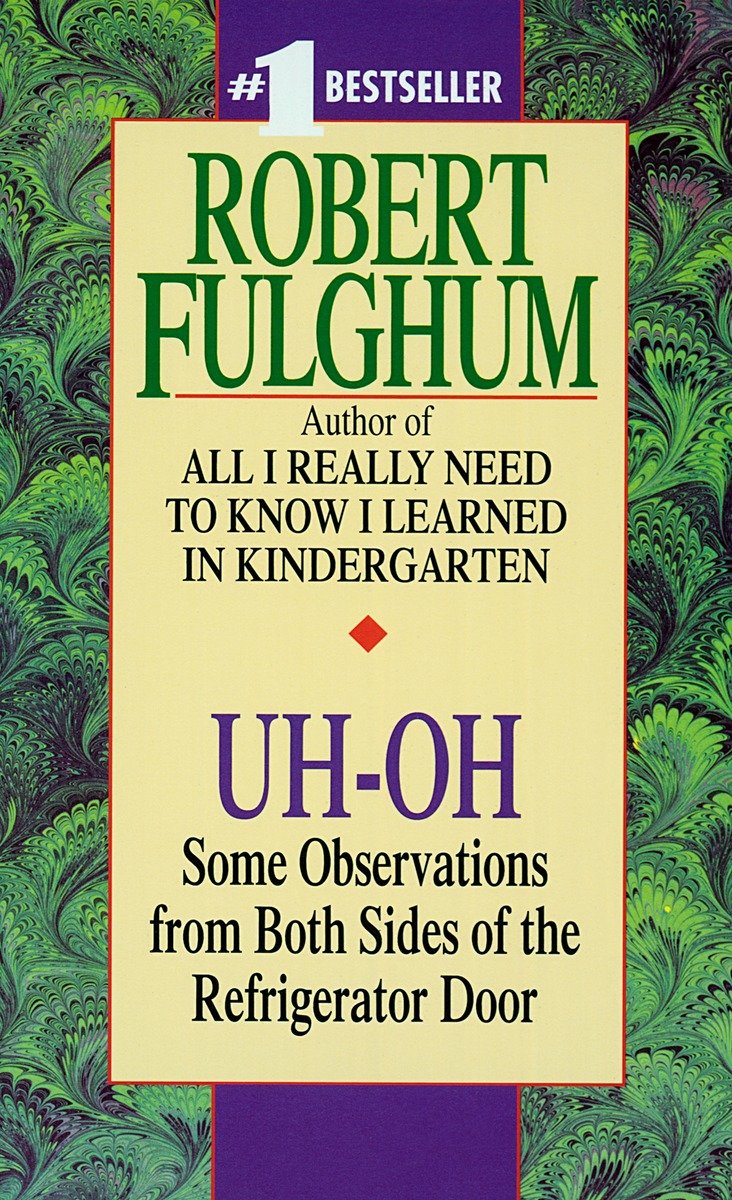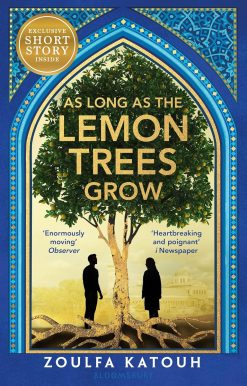Uh-Oh: Some Observations from Both Sides of the Refrigerator Door
8.00 JOD
Please allow 2 – 5 weeks for delivery of this item
Description
“Uh-oh” embraces “Here we go again” and “Now What?” and “You never can tell what’s going to happen next” and “So much for plan A” and “Hang on, we’re coming to a tunnel” and “No sweat” and “Tomorrow’s another day” and “You can’t unscramble an egg” and “A hundred years from now it won’t make any difference.” “Uh-oh” is more than a momentary reaction to small problems. “Uh-oh” is an attitude—a perspective on the universe. It is a power of an equation that summarizes my view of the conditions of existence: “Uh-huh” + “oh-wow” + “uh-oh” + “oh, God” = “ah-hah!”
Additional information
| Weight | 0.15 kg |
|---|---|
| Dimensions | 1.76 × 10.7 × 17.2 cm |
| PubliCanadation City/Country | USA |
| by | |
| format | |
| Language | |
| Pages | 256 |
| publisher | |
| Year Published | 1993-8-4 |
| Imprint | |
| ISBN 10 | 0804111898 |
| About The Author | Robert Fulghum is a writer, philosopher, and public speaker, but he has also worked as a cowboy, a folksinger, an IBM salesman, a professional artist, a parish minister, a bartender, a teacher of drawing and painting, and a father. All I Really Need to Know I Learned in Kindergarten has inspired numerous theater pieces that have captivated audiences across the country. Fulghum is also the author of many New York Times bestsellers, including It Was on Fire When I Lay Down on It, Uh-Oh, and Maybe (Maybe Not), as well as two plays: All I Really Need to Know I Learned in Kindergarten and Uh-Oh, Here Comes Christmas. He has also written two novels: Third Wish and If You Love Me Still, Will You Love Me Moving? |
| Excerpt From Book | “UH-OH” IS NOT IN ANY DICTIONARY OR THESAURUS, and is seldom seen in written form. Yet most of us utter that sound every day. And have used it all our lives. “Uh-oh” is one of the first expressions a baby learns. “Uh-oh,” or something like it, has been used as long as people have existed. And it may be the first thing Adam said to Eve after he bit into the apple. She knew exactly what he meant, too. Across the history of the human family, millions and millions of distinct sounds have come and gone as we continually reach for ways to communicate with one another. Often, the most expressive words we use are not words at all, just those shorthand sounds that represent complex thoughts—grunts and moans and snorts and clicks and whistles compounded by facial expressions and physical gestures: Uh-huh … no-no … mmmnnn … huh … hey … oops … OK … yo … ah … ha … humpf … and an almost endless number of others whose meaning and spelling cannot be conveyed with letters on paper. “Uh-oh” is way up near the top of a list of small syllables with large meanings. We say “uh-oh” to a small child who falls down or bumps his head or pinches his finger. It means that we know the child hurts, but we also know the hurt is temporary and that the child has the resources to handle the hurt and get up and go on about his business. As the child learns, he will not need to turn to a parent to kiss-it-and-make-it-well each time he scrapes himself—he will know where to find the bandages on his own. “Uh-oh” is the first wedge in weaning a child away from us into independence. The older we get, the more experience and knowledge we have, the more able we are to distinguish momentary difficulty from serious trouble. The more we know that something is “uh-oh,” not 911. If I had a chest pain, I might go to an emergency room thinking “Oh my God, heart attack!” If my doctor had the same symptoms, she might think, “Uh-oh, gas pains,” take an antacid, and go on with her work. What to me is the last gasp of my old truck is a repairable electric problem to my mechanic. “Uh-oh, there’s a short in your ignition wire.” One might even come to feel the same way about things that cannot be fixed. From the cradle we know about “Rock-a-bye-baby” and what happens when the bough breaks. In kindergarten we are reminded about these conditions. All the king’s horses and all the king’s men could not put Humpty Dumpty together again. I’m familiar with death, having been around it often in hospitals and cemeteries. If I see my own death coming, my response may well be “uh-oh.” “Uh-oh” in this sense is a frame of mind. A philosophy. It says to expect the unexpected, and also expect to be able to deal with it as it happens most of the time. “Uh-oh” people seem not only to expect surprise, but they count on it, as if surprise were a dimension of vitality. “Uh-oh” embraces “Here we go again” and “Now what?” and “You never can tell what’s going to happen next” and “So much for plan A” and “Hang on, we’re coming to a tunnel” and “No sweat” and “Tomorrow’s another day” and “You can’t unscramble an egg” and “A hundred years from now it won’t make any difference.” “Uh-oh” is more than a momentary reaction to small problems. “Uh-oh” is an attitude—a perspective on the universe. It is part of an equation that summarizes my view of the conditions of existence: “uh-huh” + “oh-wow” + “uh-oh” + “oh, God” = “ah-hah!” “HUM A LITTLE SOMETHING FOR ME.” “Why?” “So I can tell you what key your head is in.” “I don’t understand.” “Your head is a sound chamber, and every sound chamber resonates to certain notes better than others because of the shape and size and construction of the chamber.” I am a visitor in a high school science class, and the teacher is using me to demonstrate to his class that adults don’t know everything. All his students already know what their key is and how and why. I don’t. So he sends me off to do some personal research in a small, empty room. To hum and haw until I sound a note I really like—one that makes my head vibrate a little—in a comfortable and pleasing way. Easy. It’s like standing in the shower singing, with my clothes on and the water off. When the note felt right, I reported back to the classroom, where the science wizard put me in front of a microphone and said, “Hum for me.” I hummed. The oscilloscope reflected the wave structure of my voice. “B-flat,” he announced. “Fulghum, you have a head that’s tuned in the key of B-flat major—which is a sixty-cycle tone with natural overtones of D and F, forming the triadic complex of the chord.” Later I learned that trumpets and clarinets are also B-flat instruments, which means a lot of good jazz is in B-flat. Fanfares and marching-band music are often written in B-flat, which makes it the key of parades and spectacles. At the racetrack, the trumpet call announcing each race is in B-flat. “The Star-Spangled Banner” and the “Marseillaise” are in the same key. And the “William Tell Overture” should be. And my refrigerator hums in B-flat major. The electric motor of the refrigerator gives off a sixty-cycle B-flat hum, as do all motors that run on 120-volt AC current. The washing machine, dryer, electric heater, blender, hair dryer, coffeepot, and all the rest are B-flat appliances. What’s more, even when no motors are running, there is a sixty-cycle leak of energy from all the wall sockets in the house. My house is immersed in B-flat, which may explain why a man with a B-flat head like me really feels at home there. And also may explain why I feel so good near the refrigerator. I am in harmony with it. Now I know why I sometimes sing the national anthem when I invade the refrigerator in the middle of the night. — Refrigerators. On a very local scale, a refrigerator is the center of the universe. On the inside is food essential to life, and on the outside of the door is a summary of the life events of the household. Grocery lists, report cards, gems of wisdom, cartoons, family schedules, urgent bills, reminders, instructions, complaints, photographs, postcards, lost and found items, and commands. When the word GARBAGE appears there, somebody had better move it and soon. The door of the refrigerator is a chronicle of current events not found on TV or in the daily newspaper. An important art gallery is often found here as well. Postcards of paintings from museums. Scribbles from a child’s long, rainy afternoon with a box of crayons. A collection of drawings, collages, and paintings that come home from school in a steady stream. All stuck to the front of the family fridge. When you no longer have any art on the refrigerator door, something is over—your children have grown up. And when it appears again years later, it means your children have children. Grandparents are suckers for refrigerator art and will put up just about anything offered them by a child of their child. I’d like to sponsor a national contest to see who has the most amazing collection of stuff on their fridge—and produce a book of photographs of refrigerator decor. Each photograph would be accompanied by a page of explanation, including a list of ail items contained inside and on top of the refrigerator as well. This could be the coffee-table book of the year. “But my refrigerator has nothing on it—what does that say about me?” you may ask. It means you are a nice person who has carried neatness in the kitchen one step further than the Good Housekeeping Seal of Approval requires. Lighten up. Get some magnets—the heavy-duty kind—and get your stuff up on the door of the fridge. If you aren’t sure about what to put there, consult with friends. Many people know about what should go on the fridge door and will be glad to advise you. |
Only logged in customers who have purchased this product may leave a review.






Reviews
There are no reviews yet.